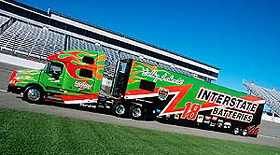DOT Drug Testing: Urinalysis Or Hair Follicle?
Topic 971 | Page 5

Not true Starcar. They did not pluck mine. They shaved my off which as you know cuts the hair off at the skin level.

My wife works in a hospital lab that does drug testing all the time.
It depends on the test, but usually most go back 3 years.
When I was in the military I worked in an area where I had to be tested every month. When I first went into that department, they went back 7 years.
I am not a lab tech so I don't fully understand the ins and outs of the folical test, but your hair length doesn't mean a thing. If it did, the military would be out of luck.
I guess I am lucky. I have never done any kind of illegal drugs. I hate needles so no IV drug use. I am allergic to MJ so no smoking. Yes, I have been around it. That is how I found out I was allergic. And other drugs. I hate putting anything in my system that makes me "loose control".
In my younger and stupider days I did drink and many times to excess. But that lesson I learned LONG ago.
Keep it safe out there, Joe S.
HOS:
Hours Of Service
HOS refers to the logbook hours of service regulations.OOS:
When a violation by either a driver or company is confirmed, an out-of-service order removes either the driver or the vehicle from the roadway until the violation is corrected.

I am not a lab tech so I don't fully understand the ins and outs of the folical test, but your hair length doesn't mean a thing. If it did, the military would be out of luck.
Is that because they all have short hair? Wouldn't they just take it from another area arm, arm put etc.?

Is that because they all have short hair? Wouldn't they just take it from another area arm, arm put etc.?
Yes, all military, except females, have short hair. Almost none when they are in bootcamp. 
I don't know that all body hair is the same. All follicle tests that I have every heard of have always been the hair off your head. I figure due to deodorant, sweat, etc, that arm pit hair would not work as well. But that is only a guess.
Keep it safe out there, Joe S.

I read on one of the forums that Celadon uses hair as well as urine testing.
Here are a few articles that will shed some light on the drug testing process from Lance Armstrong's Livestrong site. If anyone knows about the reprecussions of drug testing, it is definitely Lance. 
What Drugs Show Up on a Hair Follicle Test?
Drug testing has become part of the application process for some jobs and hair follicle testing has become more popular as a method of drug testing. Hair growth is nourished by the bloodstream, so some drugs can be detected in hair samples. According to Omega Laboratories, hair follicle testing may be preferred because the test covers a longer time period and hair cannot be tampered with prior to testing. Every half-inch of hair detects drug use for a period of 30 days. The typical hair screening test uses 1.5 inches of hair and approximately 90 to 120 strands of hair.
Cocaine
Cocaine is a highly addictive stimulant. It can be processed into a hardened form, like a rock, called crack. According to National Institute on Drug Abuse, crack cocaine gets its name from the cracking sound it makes as it is heated. The effects of cocaine include mental alertness, reduced fatigue and increased energy. It produces its effects by increasing the amount of the neurotransmitter dopamine within the brain. Dopamine receptors are associated with pleasure and movement.
Opiates
Hair follicle testing can also reveal the presence of opiates, such as morphine, codeine, heroin and Oxycontin. Most opiates are available by prescription to control or alleviate pain, but they are abused for the feeling of well-being and euphoria they produce. According to MedlinePlus, this type of drug addiction is increasing, possibly due to availability. When opiates like heroin are injected, there is the danger of addicts sharing a contaminated needle and spreading disease, such as HIV.
Methamphetamines
Amphetamines used to be widely available by prescription, but are now controlled substances due to their highly addictive nature, according to MedlinePlus. Methamphetamine is a manufactured illegal drug that goes by names such as crank and crystal. Ecstasy, another drug in this class, can also be detected through hair follicle analysis. They are central nervous system stimulants whose effects include euphoria, restlessness and weight loss.
Marijuana
Marijuana, the most commonly abused illegal drug in the United States, can be detected through hair follicle testing. According to the National Institute on Drug Abuse, parts from the hemp plant Cannabis sativa are dried and smoked in a cigarette or a pipe, releasing the chemical delta-9-tetrahydrocannabinol, or THC. When smoked, the THC moves from the lungs to the brain via the bloodstream. THC affects the cannaboid receptors in the brain responsible for pleasure, concentration, time perception and coordinated movement, causing effects including difficulty thinking and problem solving, lack of coordination and distorted perception.
Phencyclidine
Phencyclidine, or PCP, was originally developed for use as an anesthetic, according to the DEA., but its use was discontinued due to severe side effects. PCP, whose street name is angel dust or rocket fuel, is also detectable through hair follicle analysis. It is usually sold as a powder or liquid, mixed with marijuana and smoked wet. The effects of PCP include hallucinations, slurred speech, amnesia and at times, extreme hostility and psychosis. PCP is one of the most dangerous abused drugs.
Read more: What drugs show up on a hair follicle test?
OTR:
Over The Road
OTR driving normally means you'll be hauling freight to various customers throughout your company's hauling region. It often entails being gone from home for two to three weeks at a time.
HOS:
Hours Of Service
HOS refers to the logbook hours of service regulations.
WHAT DRUGS SHOW UP IN A URINALYSIS?
A urinalysis to detect drugs, also referred to as a urine drug screen, detects the presence of illegal and prescription drugs commonly abused. Different types of urine drug screens exist, but most corporate drug testing programs utilize the most basic--known as the Five-Screen. This urinalysis detects the five most popular groups of drugs.
Cannabinoids
Cannabinoid, a generic term, describes a group of compounds found in cannabis plants and synthetic compounds that bind to the cannabinoid receptors in the body. The most prevalent natural cannabinoids include tetrahydrocannabinol or THC, cannabidiol or CBD, and cannabino or CBN. Marijuana, the most widely used illegal drug in the United States, contains the psychoactive substance delta-9-tetrahydrocannabinol, according to Healthy.Net. A urinalysis can also detect extracts of the cannabis plant including hashish and hash oil.
Cocaine
Cocaine, a powder obtained from the leaves of the coca plant, stimulates the central nervous system and leads to addiction. Cocaine users snort, smoke and inject the drug in order to receive the desired euphoric effects. Cocaine increases the level of dopamine in the brain, which stimulates the pleasure responses. Over time, the body becomes tolerant, meaning the abuser requires larger doses to trigger the same effects. A report provided by the National Institute on Drug Abuse indicated in 2007 that approximately 15 percent of Americans tried cocaine by age 30.
Opiods
Opioid describes a classification of drugs derived either naturally or synthetically from the opium plant. This group includes the illegal drugs of heroin and opium, along with legal prescription medications such as codeine and morphine. Opioid drugs bind to the opioid receptors found in the brain, spinal cord and gastrointestinal tract to block the perception of pain. In addition, they trigger euphoria that can lead to addiction and abuse. When taken under the strict guidance of a doctor, opioid medications can effectively manage pain. However, the National Institute on Drug Abuse reports that nonmedical use and the abuse of prescription medications are on the rise.
Amphetamines
Amphetamines are a classification of drugs that stimulate the central nervous system, creating feelings of pleasure, increasing energy and elevating mood, as described by MedlinePlus. Amphetamines include prescription medications commonly used to treat conditions such as narcolepsy, obesity and attention deficit hyperactivity disorder. Illegal amphetamines include methamphetamine that street users commonly call speed, uppers, ice or crystal meth.
Phencyclidine
Phencyclidine, commonly called angel dust or PCP, occurs as an odorless crystal powder. Although it once was available as a prescription and used as an anesthetic in the United States, PCP is an illegal drug often abused by young adults for its mind-altering effects. PCP can be snorted, smoked or swallowed. Drug users often mix PCP with marijuana, a combination known as a "dipper," as described by the U.S. Department of Justice Drug Enforcement Administration.
Read more: What drugs show up in a urinalysis?
Dm:
Dispatcher, Fleet Manager, Driver Manager
The primary person a driver communicates with at his/her company. A dispatcher can play many roles, depending on the company's structure. Dispatchers may assign freight, file requests for home time, relay messages between the driver and management, inform customer service of any delays, change appointment times, and report information to the load planners.
List of Drugs Tested for in the DOT 5 Panel Drug Test
The DOT 5 panel drug screen is a screen for five classes of drugs. The test is mandated by the Department of Transportation to be given to employees of commercial driving companies. It has also been called the NIDA 5 and subsequently the SAMHSA 5 panels for the National Institute on Drug Abuse and the Substance Abuse and Mental Health Services Administration, respectively.
Opiates
Opiates are drugs that bind to some of the same receptors that the body's natural endorphins bind to. They are generally derived from opium, which is in turn derived from the opium poppy plant. Drugs in this class include opium, morphine, codeine, fentanyl and its derivatives, hydrocodone, oxycodone, methadone, heroin and meperidine. They are drugs of abuse for their euphoric effects, and used clinically to treat moderate to severe pain and several other conditions.
Amphetamines
Amphetamines include drugs such as speed; methylphenidate, sold as Ritalin; dextroamphetamine and amphetamine, prescribed as Adderall; and methamphetamine. These are central nervous system stimulants which are widely abused and clinically indicated for the treatment of certain conditions such as attention deficit hyperactivity disorder or ADHD, and as adjunctive treatment of severe depression and narcolepsy, a sleeping sickness.
Cocaine
Cocaine, coke, blow or snow is a drug derived from the leaves of the South American coca plant. In medicine it is used as a topical anesthetic, particularly for the eyes, nose, ears and throat. Similar to amphetamines, cocaine is an addictive central nervous system stimulant.
Cannibinoids
Cannibinoids include marijuana and hashish. The SAMHSA 5 tests screen for one of the main, active ingredients from the plant from which these drugs are derived: delta-9-tetrahydrocannabinol or THC for short. These drugs may produce heightened sensory perception, mild euphoria, increased sociability, relaxation and increased appetite at lower doses. Higher doses produces perceptual changes, panic and depersonalization, or a feeling of distance and detachment from the environment.
Phencyclidine
Phencyclidine or PCP is a drug that was invented as an anesthetic in the 1950s. Street names include angel dust, hog, wack, lovely, embalming fluid and rocket fuel. The drug causes depersonalization. It also causes numbness, lack of coordination and slurred speech. Users may feel a sense of invincibility and strength.
Read more: List of drugs tested for in the DOT 5 Panel Drug Test
DOT:
Department Of Transportation
A department of the federal executive branch responsible for the national highways and for railroad and airline safety. It also manages Amtrak, the national railroad system, and the Coast Guard.
State and Federal DOT Officers are responsible for commercial vehicle enforcement. "The truck police" you could call them.
Dm:
Dispatcher, Fleet Manager, Driver Manager
The primary person a driver communicates with at his/her company. A dispatcher can play many roles, depending on the company's structure. Dispatchers may assign freight, file requests for home time, relay messages between the driver and management, inform customer service of any delays, change appointment times, and report information to the load planners.
Blood Drug Tests for Employment
A blood drug test may be used when job applicants or employees are screened for illegal drugs. A blood test measures alcohol or drugs in the blood at the time the blood is drawn. Blood tests are not used as frequently as urine drug tests, because, unlike urinalysis, a blood test does not measure drug residues that remain in the body after the effects of the drug have worn off. Drugs that are screened for in a typical blood test for employment purposes include amphetamines, cocaine, marijuana, methamphetamines, opiates, nicotine, and alcohol.
Blood tests may be required as part of pre-employment screening or may be conducted randomly by employers, especially for employees in certain occupations, or may be required after an on-the-job accident or injury. A blood test is the only way to determine legal intoxication.
http://jobsearch.about.com/od/drugtests/qt/blood-drug-tests.htm

Well, the only hair follicle tests I've seen were when I went with a friend who was going to drive for a local company. They pulled the hair, making sure that they got the root end with the hair shaft. But I don't have a problem with any type of drug test...I just have my line drawn in the sand, I guess. I'm not a drug user, haven't been since the 60's.And as a truck driver, I have a real hate on for drivers who use drugs at all. The reputation they have, we get...it paints us all with the same brush.....
EPU:
Electric Auxiliary Power Units
Electric APUs have started gaining acceptance. These electric APUs use battery packs instead of the diesel engine on traditional APUs as a source of power. The APU's battery pack is charged when the truck is in motion. When the truck is idle, the stored energy in the battery pack is then used to power an air conditioner, heater, and other devices
New Reply:
New! Check out our help videos for a better understanding of our forum features

















Preview:
This topic has the following tags:
CDL Qualifications Choosing A Trucking Company DOT Physical Drug and Alcohol Testing Hair Follicle Drug Testing Hard Lessons Learned SAP







 TT On Facebook
TT On Facebook
Ya'll are missing a large piece of this hair follicle testing thing.... They will take atleast 10 HAIRS, WITH THE FOLLICLE ATTACHED. for their tests. btw the follicle is the hair root. So if you have weak hair, it may break off, and then they keep pluckin' em til they get the amount they require with the air root attached, and of the proper length... Good Luck....